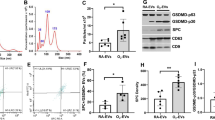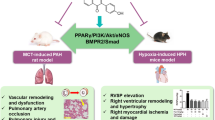Abstract
Background
Bronchopulmonary dysplasia (BPD) remains a frequent complication following preterm birth, affecting respiratory health throughout life. Transcriptome analysis in a preterm rabbit model for BPD revealed dysregulation of key genes for inflammation, vascular growth and lung development in animals exposed to hyperoxia, which could be prevented by simvastatin.
Methods
Preterm rabbits were randomized to either normoxia (21% O2) or hyperoxia (95% O2) and within each condition to treatment with 5 mg/kg simvastatin daily or control. Lung function, structure and mRNA-expression was assessed on day 7.
Results
Simvastatin partially prevented the effect of hyperoxia on lung function, without altering alveolar structure or inflammation. A trend towards a less fibrotic phenotype was noted in simvastatin-treated pups, and airways were less muscularized. Most importantly, simvastatin completely prevented hyperoxia-induced arterial remodeling, in association with partial restoration of VEGFA and VEGF receptor 2 (VEGFR2) expression. Simvastatin however decreased survival in pups exposed to normoxia, but not to hyperoxia.
Conclusion
Repurposing of simvastatin could be an advantageous therapeutic strategy for bronchopulmonary dysplasia and other developmental lung diseases with pulmonary vascular disease. The increased mortality in the treated normoxia group however limits the translational value at this dose and administration route.
Similar content being viewed by others

Log in or create a free account to read this content
Gain free access to this article, as well as selected content from this journal and more on nature.com
or
References
Doyle, L. W. et al. Ventilation in extremely preterm infants and respiratory function at 8 years. N. Engl. J. Med. 377, 329–337 (2017).
Stoll, B. J. et al. Trends in care practices, morbidity, and mortality of extremely preterm neonates, 1993−2012. Jama 314, 1039–1051 (2015).
Nardiello, C. et al. Standardisation of oxygen exposure in the development of mouse models for bronchopulmonary dysplasia. Dis. Model Mech. 10, 185–196 (2017).
Salaets, T., Gie, A., Tack, B., Deprest, J. & Toelen, J. Modelling bronchopulmonary dysplasia in animals: arguments for the preterm rabbit model. Curr. Pharm. Des. 23, 5887–5901 (2017).
Frank, L. & Sosenko, I. R. Failure of premature rabbits to increase antioxidant enzymes during hyperoxic exposure: increased susceptibility to pulmonary oxygen toxicity compared with term rabbits. Pediatr. Res. 29, 292–296 (1991).
Richter, J. et al. Functional assessment of hyperoxia-induced lung injury after preterm birth in the rabbit. Am. J. Physiol. Lung Cell Mol. Physiol. 306, L277–L283 (2014).
Jimenez, J. et al. Progressive vascular functional and structural damage in a bronchopulmonary dysplasia model in preterm rabbits exposed to hyperoxia. Int. J. Mol. Sci. 17, pii: E1776 (2016).
Salaets, T. et al. Transcriptome analysis of the preterm rabbit lung after seven days of hyperoxic exposure. PLoS ONE 10, e0136569 (2015).
Kruger, P. et al. A multicenter randomized trial of atorvastatin therapy in intensive care patients with severe sepsis. Am. J. Respir. Crit. Care Med. 187, 743–750 (2013).
Raymakers, A. J. N., Sadatsafavi, M., Sin, D. D., De Vera, M. A. & Lynd, L. D. The impact of statin drug use on all-cause mortality in patients with COPD: a population-based cohort study. Chest 152, 486–493 (2017).
Makanga, M. et al. Prevention of pulmonary hypoplasia and pulmonary vascular remodeling by antenatal simvastatin treatment in nitrofen-induced congenital diaphragmatic hernia. Am. J. Physiol. Lung Cell Mol. Physiol. 308, L672–L682 (2015).
Wong, M. J., Kantores, C., Ivanovska, J., Jain, A. & Jankov, R. P. Simvastatin prevents and reverses chronic pulmonary hypertension in newborn rats via pleiotropic inhibition of RhoA signaling. Am. J. Physiol. Lung Cell Mol. Physiol. 311, L985–L1999 (2016).
Bao, X. C. et al. Simvastatin decreases hyperbaric oxygen-induced acute lung injury by upregulating eNOS. Am. J. Physiol. Lung Cell Mol. Physiol. 314, L287–L1297 (2018).
Tschanz, S. A., Burri, P. H. & Weibel, E. R. A simple tool for stereological assessment of digital images: the STEPanizer. J. Microsc. 243, 47–59 (2011).
Roubliova, X. I. et al. Morphologic changes and methodological issues in the rabbit experimental model for diaphragmatic hernia. Histol. Histopathol. 25, 1105–1116 (2010).
Matute-Bello, G. et al. An official American Thoracic Society workshop report: features and measurements of experimental acute lung injury in animals. Am. J. Respir. Cell Mol. Biol. 44, 725–738 (2011).
O'Reilly, M., Harding, R. & Sozo, F. Altered small airways in aged mice following neonatal exposure to hyperoxic gas. Neonatology 105, 39–45 (2014).
Schittny, J. C. How high resolution 3-dimensional imaging changes our understanding of postnatal lung development. Histochem. Cell Biol. 150, 677–691 (2018).
Manitsopoulos, N. et al. Inhibition of HMGCoA reductase by simvastatin protects mice from injurious mechanical ventilation. Respir. Res. 16, 24 (2015).
Davis, B. B. et al. Simvastatin inhibits smoke-induced airway epithelial injury: implications for COPD therapy. Eur. Respir. J. 42, 350–361 (2013).
Bagnato, G. et al. Simvastatin attenuates the development of pulmonary and cutaneous fibrosis in a murine model of systemic sclerosis. Rheumatol. (Oxf.) 52, 1377–1386 (2013).
Schroll, S. et al. Effects of simvastatin on pulmonary fibrosis, pulmonary hypertension and exercise capacity in bleomycin-treated rats. Acta Physiol. (Oxf.) 208, 191–201 (2013).
Kreuter, M. et al. Effect of statins on disease-related outcomes in patients with idiopathic pulmonary fibrosis. Thorax 72, 148–153 (2017).
Zeki, A. A., Franzi, L., Last, J. & Kenyon, N. J. Simvastatin inhibits airway hyperreactivity: implications for the mevalonate pathway and beyond. Am. J. Respir. Crit. Care Med. 180, 731–740 (2009).
Al-Ghanem, G. et al. Bronchopulmonary dysplasia and pulmonary hypertension: a meta-analysis. J. Perinatol. 37, 414–419 (2017).
Lagatta, J. M. et al. The impact of pulmonary hypertension in preterm infants with severe bronchopulmonary dysplasia through 1 year. J. Pediatr. 203, 218–224.e213 (2018).
Thebaud, B. et al. Vascular endothelial growth factor gene therapy increases survival, promotes lung angiogenesis, and prevents alveolar damage in hyperoxia-induced lung injury: evidence that angiogenesis participates in alveolarization. Circulation 112, 2477–2486 (2005).
Kramer, A., Green, J., Pollard, J. Jr. & Tugendreich, S. Causal analysis approaches in Ingenuity Pathway Analysis. Bioinformatics 30, 523–530 (2014).
Oesterle, A., Laufs, U. & Liao, J. K. Pleiotropic effects of statins on the cardiovascular system. Circ. Res. 120, 229–243 (2017).
Wang, M. & Casey, P. J. Protein prenylation: unique fats make their mark on biology. Nat. Rev. Mol. Cell Biol. 17, 110–122 (2016).
Schaafsma, D. et al. The mevalonate cascade as a target to suppress extracellular matrix synthesis by human airway smooth muscle. Am. J. Respir. Cell Mol. Biol. 44, 394–403 (2011).
Takeda, N. et al. Role of RhoA inactivation in reduced cell proliferation of human airway smooth muscle by simvastatin. Am. J. Respir. Cell Mol. Biol. 35, 722–729 (2006).
Kang, S. et al. Dysfunction of vascular smooth muscle and vascular remodeling by simvastatin. Toxicol. Sci. 138, 446–556 (2014).
Kang, S. et al. Simvastatin induces the apoptosis of normal vascular smooth muscle through the disruption of actin integrity via the impairment of RhoA/Rac-1 activity. Thromb. Haemost. 116, 496–505 (2016).
Blanco-Colio, L. M. et al. 3-Hydroxy-3-methyl-glutaryl coenzyme A reductase inhibitors, atorvastatin and simvastatin, induce apoptosis of vascular smooth muscle cells by downregulation of Bcl-2 expression and Rho A prenylation. Atherosclerosis 161, 17–26 (2002).
Matsuzawa, Y. et al. Inhibitory effects of clinical reagents having anti-oxidative activity on transforming growth factor-beta1-induced expression of alpha-smooth muscle actin in human fetal lung fibroblasts. J. Toxicol. Sci. 36, 733–740 (2011).
Watts, K. L., Sampson, E. M., Schultz, G. S. & Spiteri, M. A. Simvastatin inhibits growth factor expression and modulates profibrogenic markers in lung fibroblasts. Am. J. Respir. Cell Mol. Biol. 32, 290–300 (2005).
Nakahara, K. et al. Myopathy induced by HMG-CoA reductase inhibitors in rabbits: a pathological, electrophysiological, and biochemical study. Toxicol. Appl. Pharm. 152, 99–106 (1998).
Gerson, R. J. et al. Animal safety and toxicology of simvastatin and related hydroxy-methylglutaryl-coenzyme A reductase inhibitors. Am. J. Med. 87, 28s–38s (1989).
Bradbury, P., Traini, D., Ammit, A. J., Young, P. M. & Ong, H. X. Repurposing of statins via inhalation to treat lung inflammatory conditions. Adv. Drug Deliv. Rev. 133, 93–106 (2018).
Acknowledgements
We would like to thank Katrien Luyten and Rita Van Bree for their technical assistance with immunohistochemistry and qPCR respectively. We would also like to thank Prof. Tania Roskams and Prof. Dietmar Thal for their help with the explorative search for liver and muscle toxicity. T.S. is partially funded by the SAFEPEDRUG project (supported by the agency for innovation by Science and Technology in Flanders IWT SBO 130033). This research was supported by a C2 grant from KULeuven (C24/18/101) and a research grant from the Research Foundation—Flanders (FWO G0C4419N). A.G. and J.J. are supported by the Erasmus+ Program of the European Commission (2013-0040). N.B. is a holder of a Ph.D. Fellowship grant fundamental research (FWO 11ZP518N). J.D. is partly funded by the Great Ormond Street Hospital Charity Fund.
Author information
Authors and Affiliations
Contributions
All authors fulfill the journal’s author requirements. T.S. and J.J. conceived, designed and performed the main experiments. T.S. and B.T. had a substantial contribution in acquisition, interpretation and analysis of the main data. A.G., F.L., D.d.W. and N.B. had a substantial contribution in the acquisition and analysis of several explorative outcome measures. T.S., A.G., K.A., J.D. and J.T. drafted and revised the article. All authors approved the final version before submission.
Corresponding author
Ethics declarations
Competing interests
The authors declare no competing interests.
Additional information
Publisher’s note Springer Nature remains neutral with regard to jurisdictional claims in published maps and institutional affiliations.
Rights and permissions
About this article
Cite this article
Salaets, T., Tack, B., Jimenez, J. et al. Simvastatin attenuates lung functional and vascular effects of hyperoxia in preterm rabbits. Pediatr Res 87, 1193–1200 (2020). https://doi.org/10.1038/s41390-019-0711-2
Received:
Revised:
Accepted:
Published:
Issue date:
DOI: https://doi.org/10.1038/s41390-019-0711-2
This article is cited by
-
Single, double, and triple-hit strategies to establish a long-term premature rabbit model of bronchopulmonary dysplasia
Respiratory Research (2025)
-
Time-resolved transcriptomic profiling of the developing rabbit’s lungs: impact of premature birth and implications for modelling bronchopulmonary dysplasia
Respiratory Research (2023)
-
Early diagnosis and targeted approaches to pulmonary vascular disease in bronchopulmonary dysplasia
Pediatric Research (2022)
-
Aerosol drug delivery to spontaneously-breathing preterm neonates: lessons learned
Respiratory Research (2021)


